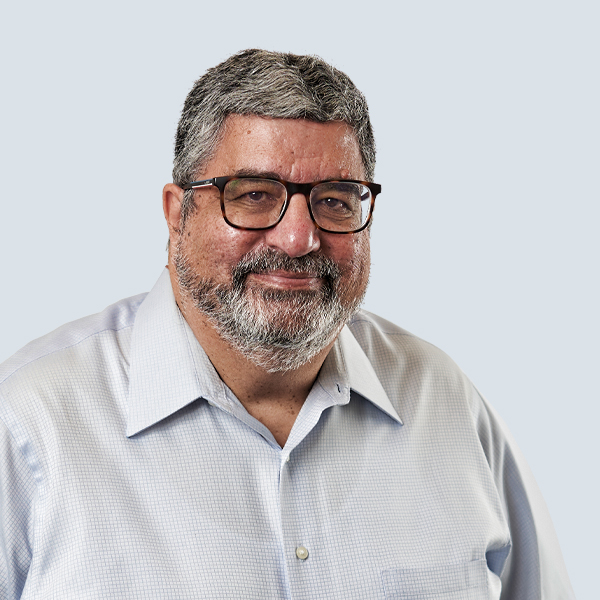December 9, 2022
We continue to build our research credentials in the same way we always have-by following our people.
At Kittelson, we’re passionate about the connection between research, innovation, and implementation, and how all of these elements work together to serve the communities in which we work. After more than 30 years of building a reputation in applied research, we’ve formalized our commitment to advancing research in transportation by establishing a Research & Innovation (R&I) practice and leadership team. Read on to learn more about this practice, and what we’ve been up to since the 2022 Transportation Research Board (TRB) Annual Meeting.
Research at Kittelson: A Brief History
“When we talk about Kittelson’s history with research, it’s really the history of our firm,” says Wayne Kittelson, who founded the firm in 1985.
Our research roots began through the efforts of individual team members, with Wayne serving on various subcommittees of the TRB Committee on Highway Capacity and Quality of Service from 1978 to 1989; Kittelson getting its first funded research project, NCHRP Project 3-46, in 1990; and Kittelson-led teams producing the first editions of FHWA’s Roundabouts: An Informational Guide and the Transit Capacity and Quality of Service Manual.
The practice has since branched into a wide range of research specialties, including geometric design, traffic signals, safety, access management, and active transportation. Academic relationships and connections that sprouted through TRB committees have brought nationally renowned researchers to the Kittelson team. Yet we continue to build our research credentials in the same way we always have-by following our people. Every new research project role comes from a Kittelson team member exploring their interests, which in turn become the interests of the firm.
Kittelson Establishes a Formal R&I Practice
As a result of the growth of the firm and our staff’s involvement and interest in research, we established a formal Research & Innovation (R&I) practice at the end of 2021. Our intent with this step was to put more resources, structure, and leadership behind one of the biggest ways we as a firm can contribute to the profession: the advancement of research.
 Including innovation in the practice further ties our research work to the Innovation Kitchen, Kittelson’s in-house idea incubator whose mission is to foster a culture of innovation by encouraging our people to ideate new approaches to better serve the communities in which we work.”‹”‹”‹”‹”‹”‹”‹ Strengthening the connection between research and innovation helps us get research off the shelf and into projects through developing tools and applications that put new findings into practice.”‹”‹”‹”‹”‹”‹”‹
Including innovation in the practice further ties our research work to the Innovation Kitchen, Kittelson’s in-house idea incubator whose mission is to foster a culture of innovation by encouraging our people to ideate new approaches to better serve the communities in which we work.”‹”‹”‹”‹”‹”‹”‹ Strengthening the connection between research and innovation helps us get research off the shelf and into projects through developing tools and applications that put new findings into practice.”‹”‹”‹”‹”‹”‹”‹
Bastian Schroeder stepped up to fill the role of national research director and is joined by Abby Morgan, Burak Cesme, and Shannon Warchol to form the firmwide R&I Leadership Team. This team is supported by regional coordinators and advisors, who collaborate to organize Kittelson’s involvement in applied research projects for federal, state, and local agencies, including the National Academy of Sciences and the Federal Highway Administration.
"Formally organizing Research & Innovation was the natural next step in Kittelson's research evolution. Having a dedicated leadership team has already helped us further grow the practice and make a bigger impact, both internally and externally."
- Bastian Schroeder, National Director of Research at Kittelson
Recent Highlights of Kittelson’s R&I Practice
Over the past year, we were thrilled to welcome several experienced researchers to our R&I practice and the larger firm.
 Dr. Nagui M. Rouphail is an internationally recognized scholar in highway capacity and operations, multi-scale traffic simulation, and the interface of traffic flow and air quality. Prior to joining Kittelson, Nagui served as Director of the Institute for Transportation Research and Education (ITRE) at North Carolina State University. Nagui also holds the rank of Distinguished University Professor in the Department of Civil, Construction, and Environmental Engineering (CCEE) at North Carolina State University, where he served from 1994-2020. He has also served as Associate Editor for several international journals, including Transportation Science, Transportation Research Part B, and the Journal of Intelligent Transportation Systems, and published more than 200 refereed journal articles, including 10 best paper awards.
Dr. Nagui M. Rouphail is an internationally recognized scholar in highway capacity and operations, multi-scale traffic simulation, and the interface of traffic flow and air quality. Prior to joining Kittelson, Nagui served as Director of the Institute for Transportation Research and Education (ITRE) at North Carolina State University. Nagui also holds the rank of Distinguished University Professor in the Department of Civil, Construction, and Environmental Engineering (CCEE) at North Carolina State University, where he served from 1994-2020. He has also served as Associate Editor for several international journals, including Transportation Science, Transportation Research Part B, and the Journal of Intelligent Transportation Systems, and published more than 200 refereed journal articles, including 10 best paper awards.
 Dr. Martin Pietrucha has over forty years’ experience in transportation engineering specializing in highway/traffic planning, design, operations, and safety; pedestrian and bicyclist interests; human factors concerns related to surface transportation design, operations, and safety; and transportation policy, funding, and financing issues for a variety of public and private institutions. Prior to joining Kittelson, Martin served as the director of Thomas D. Larson Pennsylvania Transportation Institute at Pennsylvania State University; president of the Council of University Transportation Centers, a professional organization of university-based transportation research, education, and outreach units; and president of the Research and Education Division of the American Road and Transportation Builders.
Dr. Martin Pietrucha has over forty years’ experience in transportation engineering specializing in highway/traffic planning, design, operations, and safety; pedestrian and bicyclist interests; human factors concerns related to surface transportation design, operations, and safety; and transportation policy, funding, and financing issues for a variety of public and private institutions. Prior to joining Kittelson, Martin served as the director of Thomas D. Larson Pennsylvania Transportation Institute at Pennsylvania State University; president of the Council of University Transportation Centers, a professional organization of university-based transportation research, education, and outreach units; and president of the Research and Education Division of the American Road and Transportation Builders.
 Dr. H. Gene Hawkins has an extensive background in traffic operations and is a leading expert on the subject of traffic control devices. He is a former chair of the Transportation Research Board’s Traffic Control Devices Committee and is the current Chair for the National Committee on Uniform Traffic Control Devices. Gene is the keeper of one of our industry’s most extensive online guides to the MUTCD, including a collection of previous editions, MUTCD resources, and practical information for how the MUTCD can be applied. Previously, Gene was a professor in the Zachry Department of Civil Engineering at Texas A&M University and held a joint appointment as a research engineer with the Texas A&M Transportation Institute.
Dr. H. Gene Hawkins has an extensive background in traffic operations and is a leading expert on the subject of traffic control devices. He is a former chair of the Transportation Research Board’s Traffic Control Devices Committee and is the current Chair for the National Committee on Uniform Traffic Control Devices. Gene is the keeper of one of our industry’s most extensive online guides to the MUTCD, including a collection of previous editions, MUTCD resources, and practical information for how the MUTCD can be applied. Previously, Gene was a professor in the Zachry Department of Civil Engineering at Texas A&M University and held a joint appointment as a research engineer with the Texas A&M Transportation Institute.
You might also be surprised to see how many research publications are authored by Kittelson staff! What excites us most about being a team of practitioners involved in research is that we have the opportunity to put that research into practice. Our team members are passionate about the research they help to produce, and we get to carry that passion to help implement and influence the next wave of guidance. Here is a sampling of guidebooks and papers from 2021 and 2022.
NCHRP Report 948 is a guide for transportation practitioners to improve non-motorized user safety at every intersection through planning, design, and operational treatments. Its quantitative analysis method presented is built around 20 design flags that highlight design characteristics that impact safety and quality of service for people walking and biking. Learn more here.
Authors: Bastian Schroeder, Lee Rodegerdts, Zachary Bugg, Pete Jenior, Shannon Warchol, Mike Alston, Ashley Haire, Janet Barlow, Gilbert Chlewicki
The research for NCHRP Report 969 developed new performance measures for pedestrians and cyclists and a toolbox of treatments at signalized intersections to improve pedestrian and bicyclist experiences by elevating safety considerations, reducing their delay, and enhancing accessibility. This report describes two performance measures and 28 unique treatments to make intersections more friendly for pedestrians and cyclists. Learn more here.
Authors: Kevin Lee, Bastian Schroeder, Burak Cesme, Jennifer Musselman, Molly McMormick, Ryan Casburn, Rachel Grosso, Tom Urbanik, Peter Furth, Ray Saeidi, Janet Barlow, Steven Lavrenz
NCHRP Report 992 describes current practice for counting pedestrians and performing pedestrian safety, operations, and quality-of-service analyses. Learn more here.
Authors: Paul Ryus, Anusha Musunuru, James Bonneson, Sirisha Kothuri, Christopher Monsere, Nathan McNeil, Seth LaJeunesse, Krista Nordback, Wesley Kumfer, Sophie Currin
NCHRP Report 1036 presents a step-by-step framework to help planners, designers, and anyone interested in helping build safer communities assess the potential impacts of different roadway space allocation choices and understand the inevitable tradeoffs. Learn more here.
Authors: Conor Semler, Meredyth Sanders, Camilla Dartnell, Mike Alston, Sophia Semensky, Laura Ahramjian, Katie Taylor, Rebecca Sanders, Mary Elbech, Zach Vanderkooy
The majority of AV safety research has been done through simulation, and there is a need for AV safety research based on real-world settings. This paper investigates the impact of the presence of SAE level 2 AVs in the traffic stream in reducing longitudinal traffic conflicts using Surrogate Safety Measures on a real-world open-source database of mixed traffic trajectories. Access it here.
Authors: Tanmay Das, M. Shoaib Samandar, Nagui Rouphail
This paper describes the development of a rural transit peer-grouping method as a counterpart to a method previously developed and implemented for urban providers, and compares this method to previous transit peer-grouping approaches. Access it here.
Authors: Paul Ryus, Kaitlyn Schaffer, Albert Gan, Nancy Doherty
This paper assess the impact of connected and automated vehicles (CAVs) on the entry capacity of roundabouts and develop an approach to adjust the capacity values calculated by the Highway Capacity Manual (HCM) for planning level analysis. Access it here.
Authors: Qinhua Jiang, Bastian Schroeder, Jiaqi Ma, Lee Rodegerdts, Burak Cesme, Apoorba Bibeka, Abby Morgan
Based on a review of context classification systems adopted by state departments of transportation (DOTs), this paper updates 7th Edition of the Policy of Geometric Design for Highways and Streets (Green Book)’s context classifications and introduces the concept of Transportation Expectations, which are fundamental concepts that define how users expect to move in each context. Access it here.
Authors: Nikiforos Stamatiadis, Adam Kirk, Hermanus Steyn, Jennifer Musselman, Mary Raulerson
This paper describes the development of a safety prediction method for freeways with high-occupancy vehicle (HOV) and high-occupancy toll (HOT) lanes, and summarizes key differences and similarities between this method and the current predictive method for freeways in Chapter 18 of the HSM Supplement. Access it here.
Authors: Scott Himes, James Bonneson, Vikash Gayah, Cathy Liu
Arlington County has developed the foundation for a tool that provides a mechanism for determining the optimal allocation of curb space given a block’s existing or proposed land uses and transportation services, as well as gaps in research and available data to enhance the tool’s usability. Access it here.
Authors: Alek Pochowski, Stephen Crim, Like Liu, Lake Trask, Christine Sherman Baker, Sarah Woodworth, Jessica Klion
What’s Next for R&I at Kittelson?
As we look ahead to 2023, the R&I Leadership Team is excited to continue to collaborate internally and with external support to drive our research and innovation growth and direction.
"When we help to set new standards, the whole industry advances."
- Bastian Schroeder
If you can’t tell, we’re passionate about the role of research in our profession, as well as finding ways to practically apply it to the benefit of the communities in which we work. We believe in building project teams that combine staff with strong research backgrounds, staff who focus on project work, and staff who represent the end user of the research. At its core, research and innovation is about finding better ways to do things and making them possible. As consultants, we strive to help our clients understand and apply research in innovative ways to address our industry’s biggest questions and challenges.
